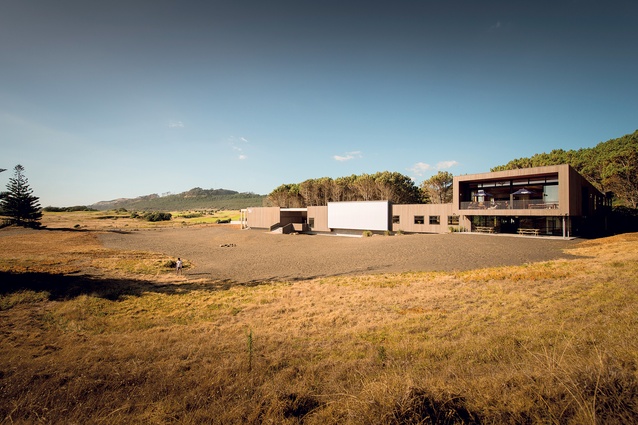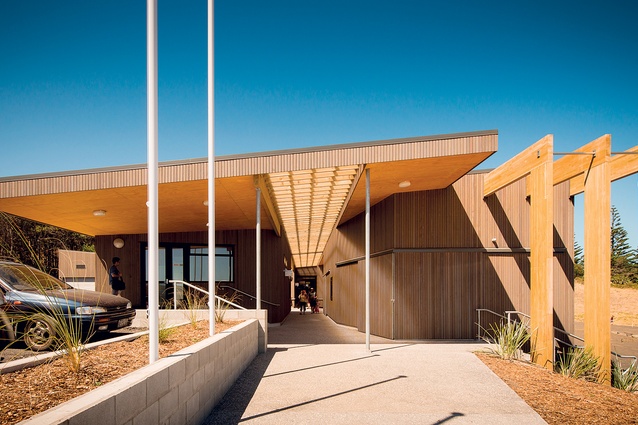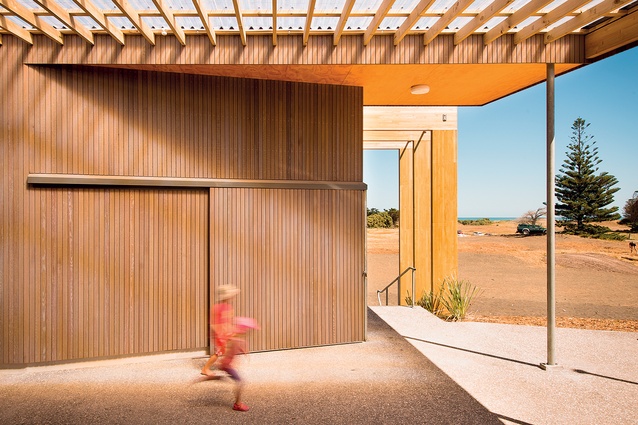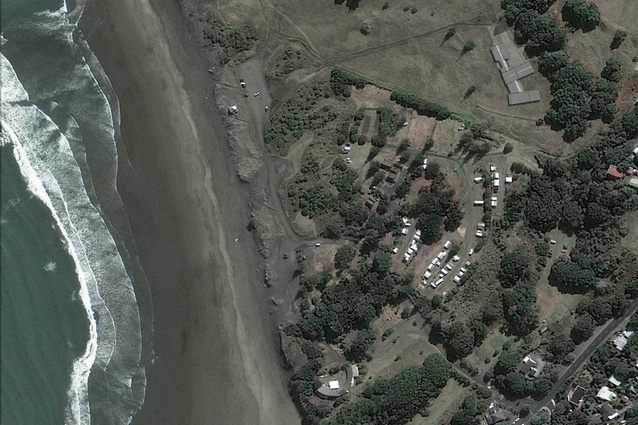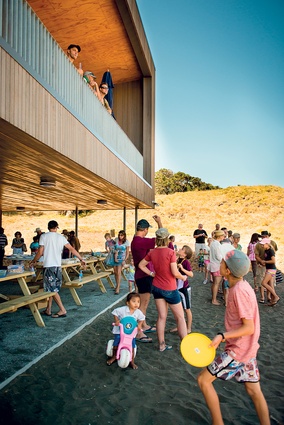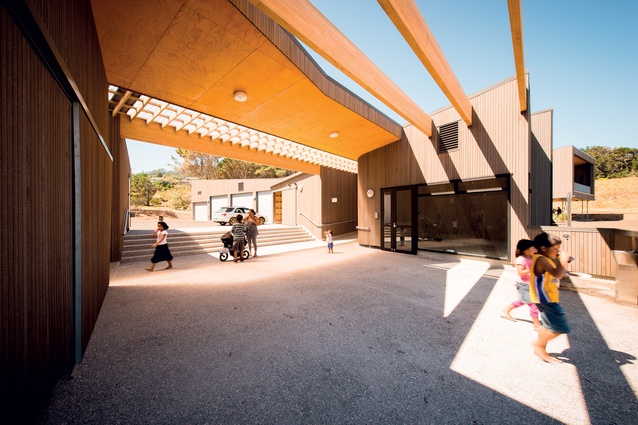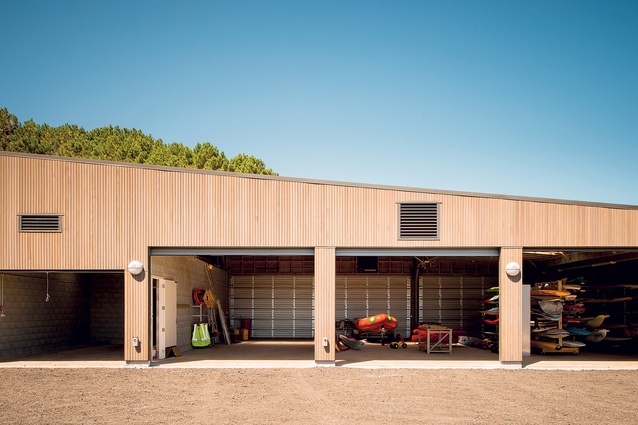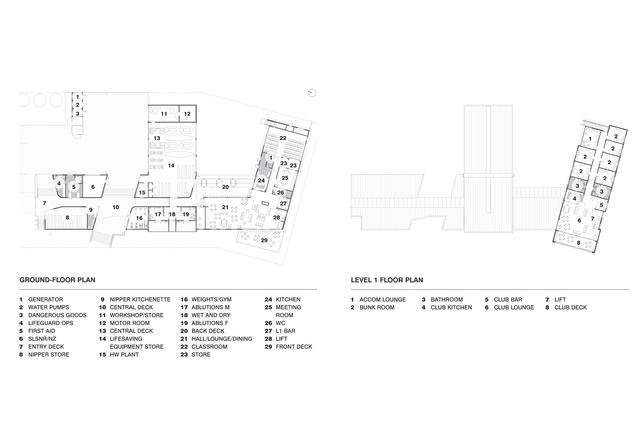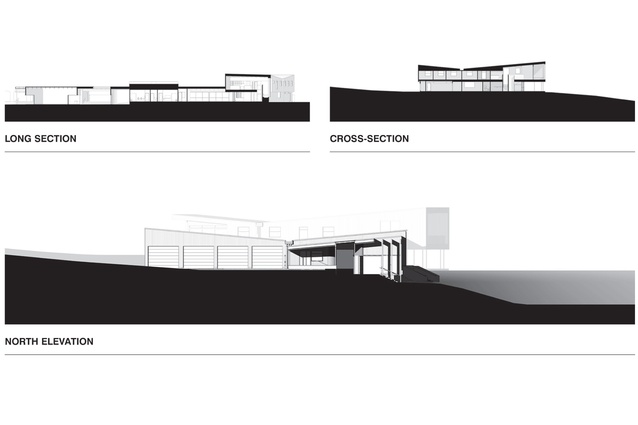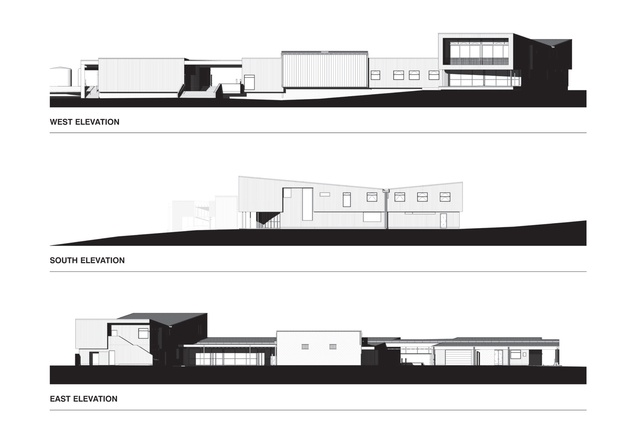The Surf Club at Muriwai
Muriwai is located just north of her celebrity sister beach, Piha, on Auckland’s west coast. Muriwai’s reputation is equally (in)famous among its 1.3 million annual visitors for dramatic surf rescues, shark attacks, gloriously glittering black sand and a plucky colony of several thousand gannets.
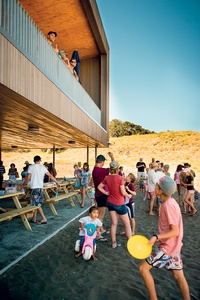
Muriwai’s new surf lifesaving clubhouse is sited 300m back from the ocean’s edge, which seems a little impractical for emergency rescues but, given that the rugged coastline is eroding at a rate of one metre each year, as a long-term solution, this decision is logical. Jasmax’s design refers to the traditional Kiwi bach but is much larger; it’s a simple wooden structure, robust, practical and a labour of love for all involved.
Located on a former golf green (number 3, apparently) belonging to the neighbouring golf club, The Surf Club at Muriwai is the result of a difficult process lasting more than 15 years for the client, the Muriwai Lifeguard Service Amenities Trust, and seven years for the architects. During this time, three designs were generated for three different potential local sites, involving numerous stakeholders, intense politics and a lack of funding.
Meanwhile, the local community was hesitant to embrace the idea of the building because, at one point, they thought it would be just a clubhouse, without facilities catering to the needs of the area. Luckily for them, the end result is a great lesson in why the Government should fund more projects like this. In this instance, it has provided 2,300 or so inhabitants with spaces for just about any activity: weddings, funerals, concerts, art exhibitions and even Treaty negotiations for local iwi – all held on a beautiful beach, while keeping people fit, saving people’s lives and building a strong community.
Tim Jago, Chairman of the Muriwai Lifeguard Service, says the locals have now fully embraced the project. “(This) couldn’t be better. It was meant to be. And, through this whole exercise, we never changed our minds as far as the space we wanted.” Euan Mac Kellar, project principal and design leader at Jasmax, explains, “There was a lot of pressure to make (the building) smaller, to cut elements off or to build it in stages but the Trust had a determination to build the whole thing. If you took parts off, it wouldn’t have functioned properly; you’d have missed local groups out.” “We’ve had close to 20,000 people use the building,” adds Jago. “It will be used at 11 o’clock this morning for a memorial service; there’ll probably be 400 or 500 people attending. So it’s been a case of ‘build it and they’ll come’.” As you can imagine, the Trust and Council have had to be innovative with fund-raising: organising concerts and events on the lawn in front of the clubhouse, in a naturally landscaped amphitheatre, to fund the build and pay the bills, including a Waitangi Day concert for about 2,000 people.
Jasmax was confident about what type of design was needed on the final choice of site, having had two attempts already, including deciphering the pragmatics of user groups, equipment sheds, maintenance, etc. “We’d worked through all the different permutations to know what we needed to achieve so this design happened pretty quickly, states Mac Kellar. “We didn’t need to change much. And we could spend time working out how to deal with the westerlies coming through.” Flexibility was essential and six different groups can occupy the building at any one time, without clashing.
In plan, the building is in a U-shape, which links, via an external covered deck, into two extra buildings near the entry. The form is a series of interlocking boxes, clearly articulated, with an upper-level form floating over the southern end; these are lightly stacked along the topography of the site. Internal corridors and external covered walkways connect the boxes. It’s simple but with enough drama to add depth. A polycarbonate-clad box in the middle breaks up the elongated timber form and lights up at night to a soft green glow, inadvertently created by a tiny green emergency light in the bathroom behind. Observed from the north and the south, the inverted roof adds another shape and mimics the natural form of the neighbouring sand dunes.
It was important to ensure the building sat within the landscape, since local concerns were raised about the sheer size of the project and its visibility from various vantage points. Jasmax prepared design guidelines for the area, including materiality, colour palette, form, etc., which was done in conjunction with and informed the design. The end result is an all-timber building. Cedar cladding has been stained to assist its transition while weathering occurs; its cocoa colour is reminiscent of the beach.
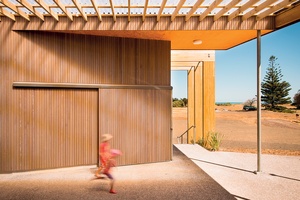
Entering the site from the northern carpark, you are welcomed onto the deck by three angular timber arms jutting out from the building and through into an outdoor enclosed walkway, past rooms for storage, first aid, equipment, training, etc., via a mustering deck where the ‘nippers’ train, and then into the primary function space. This lounge opens up on both sides; to the west, a deck and the grassy area overlooks the sea and, to the east, a sheltered courtyard space provides a sheltered, contained area to enjoy when those westerlies blow. A local mothers’ group uses this space two days a week. Inside, a lock-up bar provides sustainance to lifesavers and visitors alike. “It’s supposed to be a social environment,” explains Mac Kellar. “One of the guys (lifesavers) said, ‘Look, I spend all day on the beach so at 5 o’clock I just want to sit in the sun with my mates and have a beer’.” Hence, the building’s location aims to capture as much of the evening sun as possible.
In the southern wing of the building are storage facilities and meeting rooms, and a classroom/teaching space is used 80 days each year for training up to 60 schoolchildren from around Auckland at one time.
The northern wing is constructed of block work for added security; it protects the expensive inflatable rubber boats (IRBs) and other equipment. This space, whilst simply constructed with timber beams, has proven to possess a naturally good acoustic quality, ideal for large parties.
Most people hang out in the upstairs lounge and on the barbecue deck, which is a lovely space – naturally ventilated with glazing on three sides and a sensational view over the beach. Here, there’s a fully licensed bar, a kitchen and bunk accommodation for a maximum of 40 lifeguards, some of whom stay in residence, and for leadership training and school groups. Overlooking the back of the site is a small, private lounge for residents and where children can watch TV while the adults use the other space.
As you’d imagine, on this harsh coastal location and with thousands of people, not to mention all the lifesaving equipment, traipsing through the building each year, everything needed to be robust, practical and easy to clean. However, a much smaller element, than people and equipment, was the project’s great nemesis, suggests Mac Kellar: “Our biggest enemy on this project was sand – how do you allow sand to infiltrate the building without ruining it?” On the roof, wide gutters and huge sandboxes were designed to filter the sand (and provide a nice warm place for local albatrosses and seagulls to enjoy). Even the showers drain into a huge sand trap. From the off, club members were specific with the architects about elements which would be needed to avoid maintenance problems down the line: no drop-down showerheads from which people could do chin-ups, ways to prevent wet toilet paper being thrown onto the ceiling to see if it sticks and prohibition of teenagers rollerblading on the roof (which is not a consideration that immediately sprang to mind).
“Initially we had wanted a zero-carbon building as a target,” says Mac Kellar, “and we had planned for a green roof but we realised that it was more important that all the water is harvested off the roof and that the building is naturally ventilated.”
Landscaping will happen in time. At the rear of the site, a pine plantation is slowly being replaced with pohutukawas and other natives, and flaxes are being planted around the edges. Meanwhile, the amphitheatre bowl doubles as a flood basin, in the probable event that it’s needed.
Jasmax came aboard as architect on the project on a pro bono basis, which is why you see the firm’s logo adorning the IRBs on Piha Rescue.
“All of the people involved in the surf club are volunteers and they’re a strong community in themselves,” states Mac Kellar. “They’re very passionate and that carried through into the build. The contractors
were generous and tolerant when funding streams dried up; they put their hands in their pockets and said, ‘We’ll do the work and you can pay us when you can’. The attitude of everyone who built it was great. They were solution-focused and not looking at it from a financial-success point of view.”
Mac Kellar agrees that the Government should invest more in projects like this to build “successful happy communities”. “It will assist people to save lives by attracting more people into surf lifesaving, making our beaches safer. You can’t measure the benefits, which far outweigh all the financial stuff… The Government’s four-year planning cycle doesn’t help. Sometimes I think we have a temporal belief that we’re recent immigrants to this country, that we feel transient and might have to leave at some point. We’re not building communities for the next thousand years, we’re building communities for the next 20. Our long-term thinking is not there yet.”
Mac Kellar recently visited some Italian hillside villages that are built to last. “You think, who’d want to go back and rebuild on this steep site? These buildings are built for families and not just for one generation: for children, grandchildren, for the next 20 generations. A family home means you’ll be there forever.” Which, of course, means that a place has a powerful meaning. This is an interesting concept for today’s architectural world.

